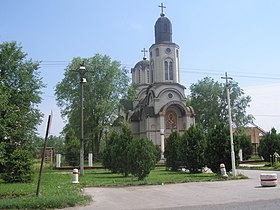Crvenka
|
Crvenka Црвенка/Crvenka |
|
|---|---|
| Village | |
| Crvenka | |
 |
|
| Coordinates: 45°39′30″N 19°27′20″E / 45.65833°N 19.45556°ECoordinates: 45°39′30″N 19°27′20″E / 45.65833°N 19.45556°E | |
| Country | Serbia |
| Province | Vojvodina |
| District | West Bačka District |
| Municipalities | Kula municipality |
| Establishment | Inhabited during the early Neolithic |
| Government | |
| • Mayor | Dragan Pavićević |
| Elevation | 86 m (282 ft) |
| Population | |
| • Total |
|
| • Density | 142/km2 (370/sq mi) |
| Time zone | CET (UTC+1) |
| • Summer (DST) | CEST (UTC+2) |
| Postal code | 25220 |
| Area code(s) | (+381) 25 |
| Car plates | SO |
Crvenka (Serbian Cyrillic: Црвенка) is a small town located in the Kula municipality, in the West Bačka District, Autonomous Province of Vojvodina, Serbia. The town has a Serb ethnic majority and its population numbered 9,001 people in 2011.
In Serbian, the town is known as Црвенка or Crvenka, in Hungarian as Cservenka, and in German as Tscherwenka or Rotweil. The name of the town derived from the Serbian word "crveno" ("red" in English).
The region around Crvenka was during its prehistory era long time covered by water, because between the Danube river and Telečka Plateau was a large lake, which was described by Roman historians as Sweet Lake. At that time it was possible to travel by boat till the Fruška Gora mountains. In the city they found remains of prehistoric animals such as the mammoth. The region was most likely inhabited during the early Neolithic when the region belonged to the Starčevo culture. Later the Celts were settled in the area around Crvenka.
It was found archaeological excavations in the immediate vicinity of objects from the Celtic and Roman times, including urns, pottery, as well as Celtic and Roman coins. On the Roman coins, the so-called Follis, the Roman Emperor Constantine the Great was depicted, and some others originated from the Republic of Venice. From the middle of the 1st century to the 4th century, the region belonged to the dominion of the Iazyges, a nomadic tribe which belonged to the Sarmatians. From the 5th century Slavs settled in the region and from the 9th century also Finno-Ugric people.
...
Wikipedia
